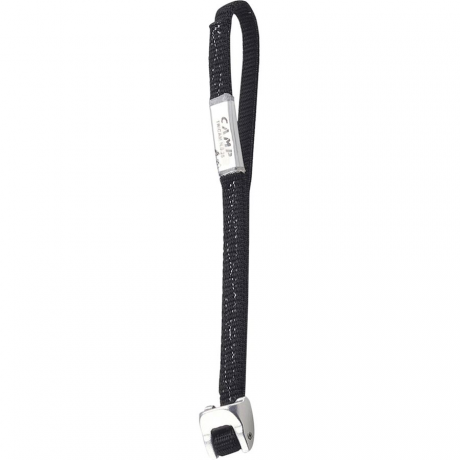CAMP USA Nylon Tricam for Sale, Reviews, Deals and Guides
Retail Price:
$23.95
$23.95
Used Value:
$14.37
$14.37
Sale Value:
$21.56
$21.56

From wandering alpine pitches to hair raising headpoints on grit, turn to the Camp USA Nylon Tricam for protecting horizontal cracks and pockets. Available in 13 different sizes for a wide range of placements, the versatile Tricam can be placed as an active cam or passive chock, making a few of these essential to every serious trad climbers rack.
Specifications
Brand:
Claimed Weight:
[.125] 0.32oz, [.25] 0.67oz, [.5] 0.92oz, [1] 1.24oz, [1.5] 1.79oz, [2] 1.94oz, [2.5] 2.72oz, [3] 3.18oz, [3.5] 4.13oz, [4] 4.87oz, [5] 4.23oz, [6] 7.06oz, [7] 9.31oz
Placement Range:
[.125] 10 - 15mm, [.25] 13.5 - 25mm, [.5] 16 - 28mm, [1] 20 - 30mm, [1.5] 26 - 38mm, [2] 29 - 41mm, [2.5] 32 - 48mm, [3] 38 - 54mm, [3.5] 41 - 60mm, [4] 45 - 64mm, [5] 57 - 89mm, [6] 73 - 105mm, [7] 92 - 140mm
Recommended Use:
trad climbing
Full Reviews
I started with the Dyneema set of four, but they freakin fit everywhere and I always use them so I bought the rest of the set up to 3.5 which is actually sort of big, definitely hand sized. I’ve never used the larger riveted ones but I’d swear by these solid headed ones. These things can make bomber placements anywhere and where anything else would be impossible like pockets and shelves and weird flaring or horizontal cracks. That they can be used passively too is just kind of a bonus. I love my tricams!

sam, backcountry.com
October 5, 2019
October 5, 2019
The larger sizes are special purpose pieces. I picked up a few to experiment with (#3, #4, #5) when climbing some cracks (thin hands to hands to fists), and they're pretty much useless for placement in a vertical crack. Any amount of vertical movement will cause them to pivot on the stinger and unseat. (SLCDs are right at home in the same placement in part due to the play in the cam lobes so that they seat more tightly in slightly irregular cracks.) That said, I am in the group of people who really like a good tricam placement, and I use the smaller sizes regularly with great success. Now I'm going to be on the lookout for some places to deploy the larger ones.

Paul Brown, backcountry.com
May 4, 2018
May 4, 2018
I love these pro. Chocks, hexes, and tri-cams each have their own benefits and drawbacks. Personally, the tri-cams are my favorite because they have both passive and active modes. These guys are mid-range in price between chocks SLCs; a good compromise. Pros: Cam & different chock modes Relatively inexpensive Their camming action is great and IMHO works better in flared cracks than SLCs Cons: They take longer to place than SLCs Retrieving can sometimes be difficult

Brian F., backcountry.com
March 21, 2016
March 21, 2016
Tricams are a little tricky at first. I feel like a lot of climbers just ignore them unfairly. Often you will have places where cams and nuts lead to confidence lacking placements... Break out the tricams! You can probably find a good tricam placement where you were failing with the cams and nuts! Its often said the pink and red are the most useful sizes with 1 or 2 sizes up from that still pretty nice. Smaller than that is more aid climbing territory. On a recent Red Rock Canyon trip I found myself increasingly reaching for my small tricams when I wasn't quite happy with available cam and nut placements.

John-Paul O'Neil, backcountry.com
April 20, 2015
April 20, 2015
I have used the Nylon tri-cam set (.5 - 3) for two years and have found numerous placements from passive nut style to the active camming position. I switch up my rack depending on the route(s) but almost always keep a few on. The last route I led, I placed 3 of the 5. I've used them in anchors and plan to pick up additional larger sizes (5-7) for the prevalent large horizontals at the top of routes. These are great. The new Evo generation offers a third placement option, making them that much more versatile. The pictures shows the nylon on the rock side, flip them for less nylon to rock contact.

peterslug, backcountry.com
May 25, 2014
May 25, 2014
Picked up a set of 5 in sizes: .5, 1, 1.5, 2.5, and 3. They seem solid but they're a bit heavy I have yet to find a placement where I needed one of them. IDK I'll keep trying to use them but I prefer my stoppers, cams, and hexs.

Dan Lexie, backcountry.com
December 28, 2013
December 28, 2013



